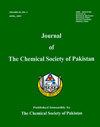Extraction and Characterization of Microcrystalline Cellulose from Walnut, Almond and Apricot Stone Shells
IF 0.5
4区 化学
Q4 CHEMISTRY, MULTIDISCIPLINARY
Journal of the chemical society of pakistan
Pub Date : 2023-01-01
DOI:10.52568/001218/jcsp/45.02.2023
引用次数: 1
Abstract
Walnut, Almond and Apricot stone shells are abundantly available agro wastes worldwide and are sources of cellulose. In this study microcrystalline cellulose were isolated from these renewable biomasses through acid hydrolysis method. Isolation of microcrystalline was performed due to its potential significance in cosmetics, medicine and food industries. Acid hydrolysis is carried out at different concentrations of sulphuric acid. Surface morphology and elemental composition of microcrystalline cellulose was characterized with Scanning electron microscopy, energy dispersive x-ray spectroscopy and FT-IR spectroscopy. SEM clearly showed that microcrystalline cellulose obtained through high acid concentration has better structural similarities with commercial microcrystalline cellulose However microcrystalline cellulose obtained with low concentration of acid showed lower fibrillation. Elemental analysis revealed that amount of Sulphur impurity (1.17-1.18) is present in microcrystalline cellulose when hydrolyzed with high H2SO4 concentration while negligible (0.10-0.72) in microcrystalline cellulose treated with low concentration of H2SO4. It is also found that carbon and oxygen contents range in Walnut, almond and Apricot C; 50.89-58.73, 54.07-55.58, 54.19-55.62, O; 39.72-48.01, 43.54-43.71 and 41.75-44.34 respectively while FT-IR shows required functional groups in prepared MCC specifically representing beta 1-4 glycosidic linkage at 849 cm-1 that depicts improved cellulose content with in the sample. Thus, this work confirms that Walnut, Almond and Apricot stone are promising sources for microcrystalline cellulose.核桃、杏仁和杏核壳中微晶纤维素的提取与表征
核桃、杏仁和杏核壳是世界范围内丰富的农业废弃物,是纤维素的来源。本研究采用酸水解法从这些可再生生物质中分离出微晶纤维素。由于微晶在化妆品、医药和食品等行业中具有潜在的应用价值,对其进行了分离。酸水解在不同浓度的硫酸下进行。采用扫描电镜、x射线能谱和红外光谱对微晶纤维素的表面形貌和元素组成进行了表征。SEM清楚地表明,高酸处理得到的微晶纤维素与商品微晶纤维素具有更好的结构相似性,而低酸处理得到的微晶纤维素则表现出更低的纤维性。元素分析表明,高H2SO4浓度水解微晶纤维素的硫杂质含量为1.17 ~ 1.18,低H2SO4浓度水解微晶纤维素的硫杂质含量为0.10 ~ 0.72,可以忽略。核桃、杏仁和杏C的碳、氧含量均在一定范围内;50.89-58.73, 54.07-55.58, 54.19-55.62, 0;分别为39.72-48.01、43.54-43.71和41.75-44.34,而FT-IR显示了制备的MCC中所需的官能团,特异性地代表了849 cm-1的β - 1-4糖苷键,表明样品中纤维素含量提高了。因此,这项工作证实了核桃、杏仁和杏核是微晶纤维素的有前途的来源。
本文章由计算机程序翻译,如有差异,请以英文原文为准。
求助全文
约1分钟内获得全文
求助全文
来源期刊
CiteScore
1.30
自引率
14.30%
发文量
41
审稿时长
3.4 months
期刊介绍:
This journal covers different research areas in the field of Chemistry. These include; Analytical Chemistry, Applied Chemistry, Biochemistry, Environmental Chemistry, Industrial Chemistry, Inorganic Chemistry, Organic Chemistry and Physical Chemistry. The journal publishes full length articles and Reviews from researchers in academia in addition to featuring comments. Chemical Research presents short, concise and critical articles offering easy-to-read overviews of basic research and applications in all areas of chemistry.

 求助内容:
求助内容: 应助结果提醒方式:
应助结果提醒方式:


